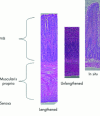Longitudinal mechanical tension induces growth in the small bowel of juvenile rats
- PMID: 15840689
- PMCID: PMC1774906
- DOI: 10.1136/gut.2004.061481
Longitudinal mechanical tension induces growth in the small bowel of juvenile rats
Abstract
Introduction: The aim of our study was to apply longitudinal force to the small bowel to increase the length of intestine in juvenile rats.
Methods: Fifty juvenile rats had double barrelled, blind loop ostomies created using an isolated segment of bowel. Our intestinal lengthening device was inserted into one of the loops and the second loop served as a control. Once the device was deployed, the experimental, control, and in situ segments of bowel were evaluated for length, weight, histology, and disaccharidase enzyme activity.
Results: Mechanical tension increased intestinal length by 149%. The lengthened bowel also exhibited a greater total weight (218%), greater mucosal weight (122%), and increased protein mass (164%) compared with the control limb of bowel. Histologically, there was a markedly increased thickness of the muscularis propria in the lengthened bowel (200% increase compared with the control limb). Functionally, we found increased total disaccharidase activity in the lengthened bowel (between 47% and 350%, depending on the particular enzyme tested; p<0.01).
Conclusion: Mechanical tension induces intestinal growth by increasing length, weight of the bowel and mucosa, and protein mass. Histological changes, such as increases in Paneth cells, suggest that increased proliferation and reorganisation of the mucosa and muscularis propria are a response to mechanical tension. Functionally, increased intestinal length corresponds with increased disaccharidase activity, thus implying potential increased absorptive capacity of the lengthened bowel.
Figures





Similar articles
-
Intestinal lengthening in rats after massive small intestinal resection.Surgery. 2009 Aug;146(2):291-5. doi: 10.1016/j.surg.2009.03.034. Epub 2009 Jun 21. Surgery. 2009. PMID: 19628087
-
Extraluminal distraction enterogenesis using shape-memory polymer.J Pediatr Surg. 2015 Jun;50(6):938-42. doi: 10.1016/j.jpedsurg.2015.03.013. Epub 2015 Mar 14. J Pediatr Surg. 2015. PMID: 25812443
-
Small intestinal morphometric and biomechanical changes during physiological growth in rats.J Biomech. 2005 Mar;38(3):417-26. doi: 10.1016/j.jbiomech.2004.04.025. J Biomech. 2005. PMID: 15652539
-
Enterogenesis by mechanical lengthening: morphology and function of the lengthened small intestine.J Pediatr Surg. 2004 Dec;39(12):1823-7. doi: 10.1016/j.jpedsurg.2004.08.022. J Pediatr Surg. 2004. PMID: 15616941
-
Restoration of mechanically lengthened jejunum into intestinal continuity in rats.J Pediatr Surg. 2011 Dec;46(12):2321-6. doi: 10.1016/j.jpedsurg.2011.09.019. J Pediatr Surg. 2011. PMID: 22152874
Cited by
-
Development of an endoluminal intestinal lengthening device using a geometric intestinal attachment approach.Surgery. 2015 Sep;158(3):802-11. doi: 10.1016/j.surg.2015.03.055. Epub 2015 May 23. Surgery. 2015. PMID: 26008962 Free PMC article.
-
Advances and Current Challenges in Intestinal in vitro Model Engineering: A Digest.Front Bioeng Biotechnol. 2019 Jun 18;7:144. doi: 10.3389/fbioe.2019.00144. eCollection 2019. Front Bioeng Biotechnol. 2019. PMID: 31275931 Free PMC article. Review.
-
A novel double-balloon catheter device for fully endoluminal intestinal lengthening.Pediatr Surg Int. 2014 Dec;30(12):1223-9. doi: 10.1007/s00383-014-3612-9. Epub 2014 Oct 16. Pediatr Surg Int. 2014. PMID: 25319796
-
Intestinal mucosal atrophy and adaptation.World J Gastroenterol. 2012 Nov 28;18(44):6357-75. doi: 10.3748/wjg.v18.i44.6357. World J Gastroenterol. 2012. PMID: 23197881 Free PMC article. Review.
-
Distraction Enterogenesis in Rats: A Novel Approach for the Treatment of Short Bowel Syndrome.Pathophysiology. 2024 Jul 30;31(3):388-397. doi: 10.3390/pathophysiology31030029. Pathophysiology. 2024. PMID: 39189165 Free PMC article.
References
-
- Vanderhoof J, Young R. Enteral and parenteral nutrition in the care of patients with short-bowel syndrome. Baillieres Best Pract Res Clin Gastroenterol 2003;17:997–1015. - PubMed
-
- Williamson R. Intestinal adaptation (first of two parts). Structural, functional and cytokinetic changes. N Engl J Med 1978;298:1393–402. - PubMed
-
- Fisher K, Dhanvantari S, Drucker D, et al. Intestinal growth is associated with elevated levels of glucagon-like protein 2 in diabetic rats. Am J Physiol 1997;273:E815–20. - PubMed
-
- Hine I. Block staining of mammalian tissues with hematoxylin and eosin. Stain Technol 1981;56:119. - PubMed
-
- Howard L, Heaphey L, Fleming CR, et al. Four years of North American registry home parenteral nutrition outcome data and their implications for patient management. J Parenter Enteral Nutr 1991;15:384–93. - PubMed
MeSH terms
Substances
LinkOut - more resources
Full Text Sources
Other Literature Sources
